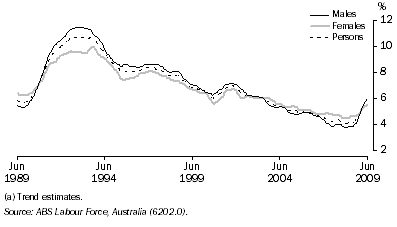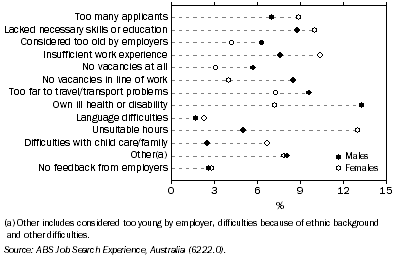UNEMPLOYED PEOPLE
In the monthly LFS, people aged 15 years and over are considered to be unemployed if they satisfy three criteria: they are not employed; they are available to start work; and they are taking active steps to find work.
Two important measures of unemployment are the number of people unemployed and the unemployment rate. The unemployment rate, defined as the number of unemployed people expressed as a percentage of the labour force, offers an insight into the level of unutilised labour resources within the economy.
Movements in the unemployment rate over the last 20 years have been dominated by the economic downturn of the early 1990s, the subsequent period of economic recovery and the recent global financial crisis. In trend terms, the unemployment rate peaked at 10.7% in September 1992, before generally falling from the mid-1990s to 4.1% in February 2008. Since then, the unemployment rate has been steadily increasing (graph 8.34).
For most of the period from June 1989 to June 2009, the male unemployment rate was higher than the female unemployment rate, including from March 2009 to June 2009. However, from June 1989 to September 1990, and from August 2003 to January 2009, the female rate was higher than the male rate.
8.34 Unemployment rate(a)

In conjunction with the decline in the unemployment rate, the number of unemployed people has generally fallen from the levels recorded in the early 1990s although it has increased sharply over the last year.
Over the past five years the proportion of unemployed people who have been in long-term unemployment (i.e. lasting 52 weeks or more) has steadily decreased, from 20% in 2004-05 to 14% in 2008-09 (table 8.35). In contrast, the proportion of unemployed people who have been in relatively short-term unemployment (lasting less than 26 weeks) has increased, from 68% in 2004-05 to 74% in 2008-09.
8.35 UNEMPLOYED PERSONS(a), By duration of unemployment |
|
| Weeks | 2004-2005 | 2005-2006 | 2006-2007 | 2007-2008 | 2008-2009 |
|
| Under 26 | % | 68.3 | 68.9 | 70.8 | 73.3 | 73.7 |
 | Under 8 | % | 42.8 | 41.8 | 43.4 | 46.3 | 43.2 |
 | 8 to under 26 | % | 25.5 | 27.1 | 27.3 | 27.0 | 30.5 |
| 26 to under 52 | % | 12.3 | 12.9 | 12.4 | 11.6 | 12.4 |
| 52 and over | % | 19.5 | 18.3 | 16.9 | 15.0 | 13.9 |
 | 52 to under 104 | % | 8.0 | 7.9 | 7.7 | 7.4 | 7.4 |
 | 104 and over | % | 11.4 | 10.3 | 9.1 | 7.6 | 6.6 |
| Persons | '000 | 539.3 | 529.4 | 492.9 | 471.7 | 562.2 |
|
| (a) Annual averages. |
| Source: ABS Labour Force, Australia, Detailed - Electronic Delivery (6291.0.55.001). |
Educational qualifications can have a significant bearing on labour market prospects. Table 8.36 shows the relationship between the level of highest non-school qualifications and the duration of unemployment. At July 2008, the proportion of unemployed people who had been unemployed for a year or more was highest among those with a Certificate III/IV (19%), compared with those with a Certificate I/II (18%) or Bachelor degree or higher (15%), and lowest among those with an Advanced diploma or diploma (9%).
8.36 UNEMPLOYED PERSONS, Level of highest non-school qualification and duration of unemployment - July 2008 |
|
 |  | Duration of current period of unemployment (weeks) |  |  |
 |  | Under 8 | 8 to under 26 | 26 to under 52 | 52 and over | Total | Number |
 |  | % | % | % | % | % | '000 |
|
| Level of highest non-school qualification(a) |  |  |  |  |  |  |
 | Bachelor degree or above | 49.0 | 26.6 | 8.9 | 15.4 | 100.0 | 46.9 |
 | Advanced diploma or diploma | 48.6 | 30.0 | 12.2 | 9.1 | 100.0 | 33.3 |
 | Certificate III / IV | 47.8 | 26.2 | 7.3 | 18.7 | 100.0 | 43.8 |
 | Certificate I / II(b) | 38.8 | 31.2 | 12.3 | 17.7 | 100.0 | 29.3 |
| Without non-school qualification | 38.0 | 29.9 | 17.1 | 15.0 | 100.0 | 261.6 |
| Total(c) | 40.8 | 29.5 | 14.6 | 15.1 | 100.0 | 422.6 |
|
| (a) For further details on how level of highest non-school qualification is determined see Education and Work, Australia (6227.0). |
| (b) Includes 'Certificate not further defined'. |
| (c) Includes 'Level not determined'. |
| Source: ABS Job Search Experience, Australia (6222.0). |
Unemployed people encounter a variety of difficulties in finding work. Women were more likely than men to report 'Unsuitable hours' as their main difficulty (13% compared with 5%), 'Insufficient work experience' (10% compared with 8%) and 'Difficulties with child care, other family responsibilities' (7% compared with 3%). Men were more likely than women to report their main difficulty as 'Own ill health or disability' (13% compared with 7%), 'Too far to travel/transport problems' (10% compared with 7%) and 'Considered too old by employers' (6% compared with 4%) (graph 8.37).
8.37 UNEMPLOYED PERSONS, Main difficulty in finding work
- July 2008

 Print Page
Print Page